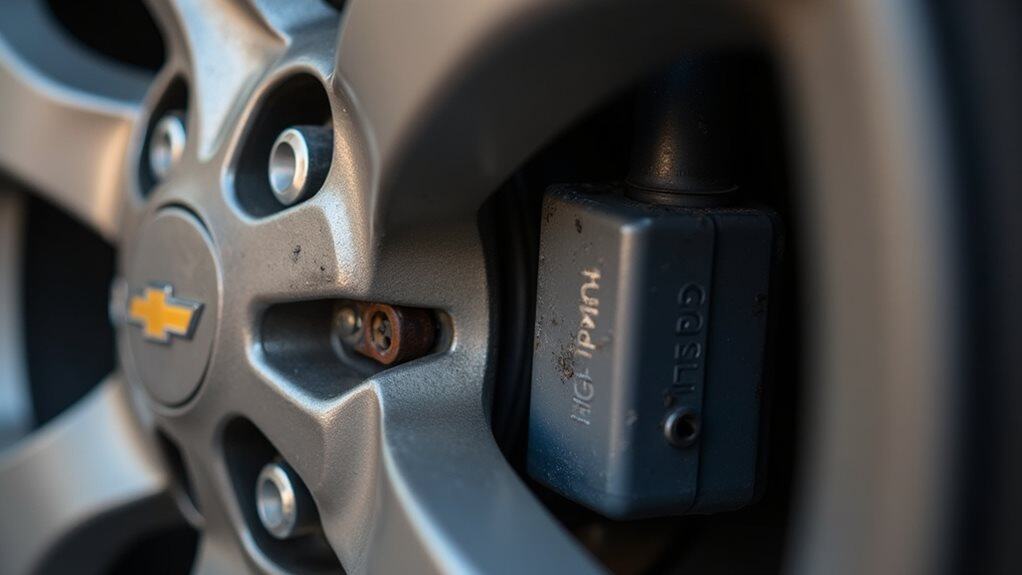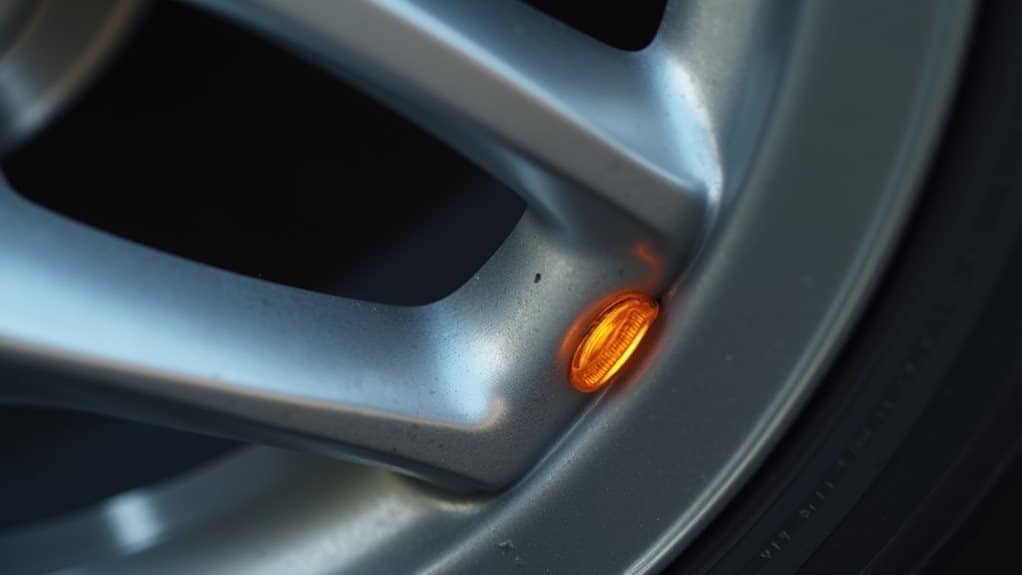“SVC Tire Monitor” on your Chevy Malibu means the TPMS or its communication components—wheel sensors, RF receiver, or vehicle control module—have a fault and can’t reliably report tire pressures. You should first check cold tire pressures with a gauge and inspect for damage; if pressures are correct but the alert stays on, a TPMS scan tool will identify non‑reporting sensors or module errors. Sensors often fail after 5–7 years or after tire service, and proper relearn or professional diagnostic work will be needed to restore normal operation; continue below to learn how to diagnose and fix it.
Quick Tips
- “SVC Tire Monitor” means the Malibu’s TPMS has detected a system fault, not necessarily a flat tire.
- First step: manually check all four tire pressures with a reliable gauge when tires are cold.
- Common causes: dead/failed wheel sensors, sensor batteries, damaged valves, receiver or BCM communication faults.
- Use a TPMS scan tool to read fault codes, identify non‑reporting sensors, and confirm the exact problem.
- Fixes include sensor replacement or relearn, receiver/module repair, and professional diagnostic tools and software.
What “sVC Tire Monitor” Means on a Chevy Malibu

“SVC Tire Monitor” on a Chevy Malibu is a dashboard message that tells you there’s a problem with the vehicle’s Tire Pressure Monitoring System (TPMS), not necessarily with the tires themselves.
It means one or more TPMS sensors aren’t sending reliable data, possibly due to dead sensor batteries, damage, or improper programming. The display may show blanks or dashes instead of pressures. It often appears when a sensor has stopped communicating after tire service or battery failure sensor failure. Professional diagnosis may be needed to check for faulty sensors and ensure the system is properly scanned and repaired.
How the TPMS in the Malibu Works
The TPMS on a Chevy Malibu uses wheel-mounted sensors that talk to central modules, so you can see each tire’s pressure and get timely warnings if something’s wrong.
Sensors send RF to the RCDLR, which forwards data to the BCM; the DIC and IPC show individual tire pressures.
Sensors sample more often when driving, conserve battery when parked, and require relearn after changes. Regular inspection of related electrical connections can prevent false warnings and erratic behavior, especially if there are issues with the engine ground.
The BCM, IPC, and RCDLR manage TPMS communications and alerts.
Common Reasons the Warning Appears

When your Malibu shows a tire-monitor warning, don’t assume it’s just low air; a range of mechanical, electronic, and environmental issues can cause the alert.
Failed TPMS sensors, wiring or control-module faults, slow leaks, valve or tire damage, and temperature-related pressure drops all trigger the SVC light.
Some fixes need dealer diagnostic tools, sensor replacement, or system calibration to clear the message.
An exhaust leak before the O2 sensor can also cause related warning lights and engine performance issues by creating a lean condition that confuses onboard diagnostics.
How to Check Your Tires First
Before you open the valve cap, check tire pressure manually with a reliable PSI gauge when the tires are cold — that means the car’s been parked at least three hours or driven less than one mile at moderate speed — so your readings match the manufacturer’s recommended values found on the driver’s door jamb or owner’s manual.
While recording each tire’s PSI, visually inspect the tread and sidewalls for damage like cuts, bulges, embedded objects, or uneven wear, and use a penny or tread gauge to verify remaining depth.
If pressure is off, add or release air to reach the specified PSI, then recheck and replace valve caps to preserve the seal.
Cold temperatures can cause pressure drops overnight, so monitor for temperature-related pressure changes and recheck when conditions change.
Check Tire Pressure Manually
Start by checking your tires when they’re cold—parked at least three hours or driven less than one mile at moderate speed—because heat raises air pressure and gives a false high reading;
use a reliable gauge, remove the valve cap, press the gauge straight and firmly onto the valve stem until you get a steady reading, note the PSI, then replace the cap and record the value for each tire.
Inspect Tires for Damage
Walk around each tire and inspect it closely, using a flashlight or mirror for hard-to-see spots, because a thorough visual exam lets you spot cuts, bulges, cracks, embedded objects, and uneven wear before they become safety hazards.
Check sidewalls for bubbles or separation, scan tread for nails or cupping, verify tread depth and DOT date, and examine the spare for damage and correct pressure.
Diagnosing a Faulty TPMS Sensor

When diagnosing a faulty TPMS sensor, begin by confirming actual tire pressures with a reliable gauge, since a warning light can come on even when inflation is correct; this simple verification separates true low-pressure events from sensor or system faults.
Use a TPMS scan tool or OBD-II reader to pull codes, inspect valves for damage or corrosion, swap tires to isolate the bad sensor, and plan replacement if battery or electronics failed.
Relearn and Reset Procedures for Malibu TPMS
After you’ve confirmed a faulty TPMS sensor or corrected tire pressures, you’ll need to put the Malibu into its relearn or reset mode so the vehicle can recognize each sensor’s ID and location; this is a procedural step that restores accurate tire-pressure monitoring after sensor replacement, rotation, or battery failure.
Turn ignition on, set parking brake, then use key fob buttons, dashboard menu, or reset button to start relearn.
Follow clockwise sensor sequence, activate each sensor with a scan tool or fob, confirm horn beeps, then drive 10–15 minutes to finalize registration.
When to Replace TPMS Sensors

Although TPMS sensors are designed to last several years, you should replace them as soon as they show persistent signs of failure or reach expected end-of-life, because continuing to drive with degraded sensors undermines accurate tire-pressure monitoring and vehicle safety.
Replace sensors when they give erratic readings, blink or trigger constant warnings, fail after tire service, or exceed typical 5–7 year battery life, since batteries aren’t replaceable.
Costs and Time for Repair or Replacement
Once you’ve decided to replace failing TPMS sensors or they’ve reached their 5–7 year battery life, you’ll want to understand the costs and time involved so you can plan the repair.
Relearn runs about $49–$72, done in under two hours with a scan tool. Full sensor replacement averages $314–$368, parts and labor; cheaper aftermarket options exist, but warranties vary.
Tips to Prevent Future SVC Tire Monitor Alerts

Keeping your TPMS (Tire Pressure Monitoring System) healthy starts with routine care and attention to tires and sensors; by checking tire pressure monthly with a reliable gauge, you’ll catch slow leaks and avoid both underinflation and overinflation that often trigger SVC Tire Monitor alerts.
Clean valve stems, rotate tires every 5,000–7,000 miles, use compatible sensors, recalibrate after service, and avoid impacts.
When to Seek Professional Diagnostic Help
If the SVC Tire Monitor light stays on after you’ve checked and adjusted tire pressures, you should get a professional diagnostic scan because persistent warnings often mean a faulty TPMS sensor or module.
Technicians use advanced OBD2 or OEM diagnostic tools to read TPMS-specific fault codes, identify which wheel sensor isn’t reporting, and determine whether a sensor, wiring, or module replacement is needed.
Don’t try complex sensor programming or tire demounting yourself, since proper relearn procedures and sensor coding require professional equipment and training.
Persistent Warning Light
Frequently, a persistent SVC Tire Monitor warning means you need a professional inspection because the underlying issue often goes beyond simple tire inflation; you should confirm pressures first, but when lights stay on or readings vanish from the display, a trained technician will use diagnostic tools to test each TPMS sensor, the receiver module, and the vehicle’s control network to isolate failures.
If warnings persist after checks, get expert diagnostics.
Diagnostic Tool Needed
When the SVC Tire Monitor message and its warning light don’t clear after you’ve confirmed correct tire pressures, you’ll want a professional diagnostic—because the problem often involves the TPMS sensors, the receiver or the vehicle’s control modules, and those require specialized tools to isolate and fix.
A shop uses TPMS activation tools, updated EL 52545 software, OBD2 TPMS scanners and proper antenna placement to identify faulty sensors, dead batteries, or module faults and perform relearn procedures.
Wrapping Up
When your Chevy Malibu shows “SVC Tire Monitor,” check tire pressures first, because the TPMS (tire pressure monitoring system) often flags low or uneven pressure; correct pressures and reset the system if needed. If the light persists, inspect or replace a faulty TPMS sensor—sensors fail from battery depletion, corrosion, or damage. Professional diagnostics help when wiring or module faults are suspected. Address issues promptly to maintain safety, fuel efficiency, and proper tire wear.

